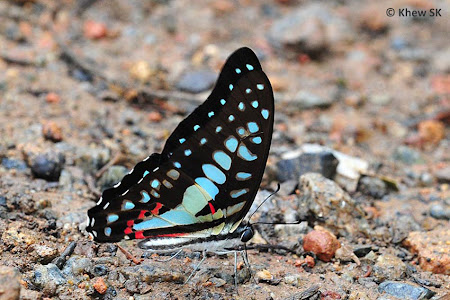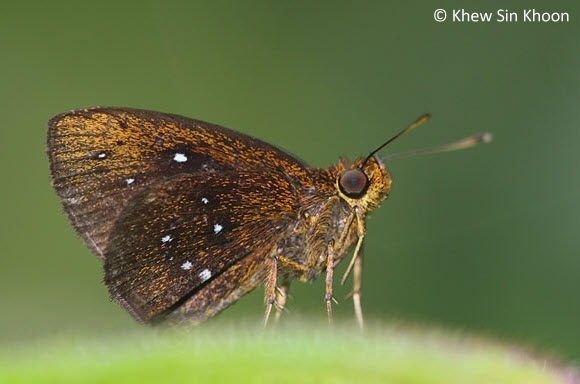Connecting Areas of Biodiversity

A group shot with NParks staff at Singapore Botanic Gardens
This morning, I had a sharing session with a group of staff from the National Parks Board. Most of the staff were from the Landscaping and Arboriculture and Streetscape East Branches of the Streetscape Division, National Biodiversity Centre Division and Community Parks. It was also an opportunity for me to learn a bit more about NParks' Nature Ways and how these are intended to enhance biodiversity in Singapore.

Sharing about butterflies with the NParks staff at Ridley Hall, Singapore Botanic Gardens
The morning started with a talk about butterflies, covering various aspects about their biology, ecology and habitats, their relationship with plants and designing and landscaping to attract butterflies. It was nice to see a very attentive audience, especially on a Saturday (an off-day for everyone!). The staff asked very valid and relevant questions to enhance their knowledge about butterflies and how they exist in the environment.

I was also pleased to note that many of the NParks staff had backgrounds in architecture, landscape architecture, urban planning, botany and arboriculture. I was glad that I had customised my talk to focus more on plants, landscape and how butterflies relate to plants, which was more relevant to my audience's areas of interest.

Receiving a token of appreciation from Director, Streetscape Division, Oh Cheow Sheng
So what exactly are Nature Ways? From NParks' Quarterly Newsletter, My Green Space, "Nature Ways are linear, green corridors along roadsides that have been developed to connect areas of high biodiversity to urban areas. The aim is to attract birdlife and butterflies from nature areas and parks to areas where people can appreciate them, and be more aware of the beautiful natural environment around them."

Receiving a token of appreciation from Director, Streetscape Division, Oh Cheow Sheng
So what exactly are Nature Ways? From NParks' Quarterly Newsletter, My Green Space, "Nature Ways are linear, green corridors along roadsides that have been developed to connect areas of high biodiversity to urban areas. The aim is to attract birdlife and butterflies from nature areas and parks to areas where people can appreciate them, and be more aware of the beautiful natural environment around them."

Source : © My Green Space - a Quarterly NParks Publication
To create Nature Ways, NParks designs these eco-corridors to replicate the natural structures of forests as far as is possible. Trees, shrubs and groundcovers would be planted on available roadside planting strips to re-create habitats similar to those found in the emergent, mid-canopy, understory and undergrowth layers of natural forests.
Relevant species of plants are then selected for the emergent, mid-canopy, understory and undergrowth layers to create conducive environments for birds and butterflies to encourage activities like nesting and feeding. In the understory and undergrowth layers, nectaring and host plants for butterflies are planted to attract various species like the Plain Tiger, Leopard, Mottled Emigrant and so on.
The group also had a discussion about doing a butterfly biodiversity survey that will help to fine-tune the species to attract to the various nature ways, depending on their locations and proximity to the source nodes of high butterfly diversity (e.g. the nature reserves or larger parks) This is important, as it would then target the correct species and also helps with species recovery of the rarer species by increasing the host plants relevant to the specific location of the nature way.

Source : © National Parks Board - Tengah Nature Way
Currently, the longest nature way is the Tengah Nature Way. Spanning 13km in length, Tengah Nature Way is the Singapore’s longest Nature Way so far. It refers to the area of largely residential land between the Bukit Timah and Central Catchment Nature Reserves and the Western Catchment (SAFTI Live-Firing Area). There are already nature ways at Admiralty, Kheam Hock, Tampines and Yishun.

At the end of my talk, the group went on a short walk at the Singapore Botanic Gardens to see if we can spot any butterflies. We moved to the Swan Lake area, where there are more nectaring plants. At the edge of the pond, where a row of Cassia fistula and Caesalpinia pulcherrima were grown, a number of Pierid butterflies - Common Grass Yellow, Lemon Emigrant and Orange Emigrant were up and about.

Watching an Orange Emigrant oviposit
As if on cue, a female Orange Emigrant descended from the treetops and oviposited on a leaf of the Peacock Flower bush. The Lemon Emigrants were also flying actively amongst the foliage of the Cassia fistula trees. Walking further towards the Ginger Garden we spotted a number of Common Palmfly in the shaded area. As the weather was hot and sunny, there were a number of butterflies up and about. Over in the rainforest area, the group spotted species like the Painted Jezebel, a Common Mormon and a Short Banded Sailor.

I was pleased to note that quite a few of the NParks staff were already quite conversant with butterflies and could capably identify the more common urban species. It will only be a matter of time and with more field experience that the staff can be competent butterfly guides in the nature ways and be able to educate visitors and members of the public on the butterfly diversity along the nature ways!

It was a worthwhile morning for me to share information about butterflies with the NParks staff and also learn more about the development of nature ways as a strategy to habitat de-fragmentation and conserving our precious biodiversity in Singapore. With 'customised' and selective planting relevant to the locations of the nature ways, these eco-corridors will no doubt help in creating a conducive environment for butterflies to move across the island as well as aid in species conservation in Singapore.
Text by Khew SK : Photos by Jason Yong and Huang CJ
Further References And Reading :
Relevant species of plants are then selected for the emergent, mid-canopy, understory and undergrowth layers to create conducive environments for birds and butterflies to encourage activities like nesting and feeding. In the understory and undergrowth layers, nectaring and host plants for butterflies are planted to attract various species like the Plain Tiger, Leopard, Mottled Emigrant and so on.
The group also had a discussion about doing a butterfly biodiversity survey that will help to fine-tune the species to attract to the various nature ways, depending on their locations and proximity to the source nodes of high butterfly diversity (e.g. the nature reserves or larger parks) This is important, as it would then target the correct species and also helps with species recovery of the rarer species by increasing the host plants relevant to the specific location of the nature way.

Source : © National Parks Board - Tengah Nature Way
Currently, the longest nature way is the Tengah Nature Way. Spanning 13km in length, Tengah Nature Way is the Singapore’s longest Nature Way so far. It refers to the area of largely residential land between the Bukit Timah and Central Catchment Nature Reserves and the Western Catchment (SAFTI Live-Firing Area). There are already nature ways at Admiralty, Kheam Hock, Tampines and Yishun.

At the end of my talk, the group went on a short walk at the Singapore Botanic Gardens to see if we can spot any butterflies. We moved to the Swan Lake area, where there are more nectaring plants. At the edge of the pond, where a row of Cassia fistula and Caesalpinia pulcherrima were grown, a number of Pierid butterflies - Common Grass Yellow, Lemon Emigrant and Orange Emigrant were up and about.

Watching an Orange Emigrant oviposit
As if on cue, a female Orange Emigrant descended from the treetops and oviposited on a leaf of the Peacock Flower bush. The Lemon Emigrants were also flying actively amongst the foliage of the Cassia fistula trees. Walking further towards the Ginger Garden we spotted a number of Common Palmfly in the shaded area. As the weather was hot and sunny, there were a number of butterflies up and about. Over in the rainforest area, the group spotted species like the Painted Jezebel, a Common Mormon and a Short Banded Sailor.

I was pleased to note that quite a few of the NParks staff were already quite conversant with butterflies and could capably identify the more common urban species. It will only be a matter of time and with more field experience that the staff can be competent butterfly guides in the nature ways and be able to educate visitors and members of the public on the butterfly diversity along the nature ways!

It was a worthwhile morning for me to share information about butterflies with the NParks staff and also learn more about the development of nature ways as a strategy to habitat de-fragmentation and conserving our precious biodiversity in Singapore. With 'customised' and selective planting relevant to the locations of the nature ways, these eco-corridors will no doubt help in creating a conducive environment for butterflies to move across the island as well as aid in species conservation in Singapore.
Text by Khew SK : Photos by Jason Yong and Huang CJ
Further References And Reading :
- Creating Ways for Nature to Travel
- Tengah Nature Way to be Launched Next Year
- Tengah Nature Way - Media Factsheet
- 10 Ideas to Live Better














































